Evidence Based Practice Report: Nursing Student Bullying
VerifiedAdded on 2023/04/21
|13
|1955
|410
Report
AI Summary
This report provides a critical evaluation of two research articles concerning bullying in nursing education. The first article, a qualitative study by Hakojärvi, Salminen, and Suhonen (2014), explores the experiences of Finnish healthcare students and their coping strategies in clinical training. It examines the research question, design, measurement issues, data collection, sampling, ethical considerations, and data analysis, highlighting the study's strengths in capturing true emotions and perceptions. The second article, a quantitative study by Mabrouk Abd El Rahman (2014), investigates Egyptian nursing students' perceptions of bullying behaviors and their coping strategies. This report assesses the research question, design, measurement issues, data collection, sampling, ethical considerations, and data analysis, noting the study's rigorous approach to data collection and statistical analysis. The report synthesizes the findings, comparing the qualitative and quantitative approaches and emphasizing the need for cultural changes to reduce bullying and provide support. Both studies effectively address their research questions and arrive at similar conclusions, offering valuable insights into the prevalence and impact of bullying in nursing education.

Evidence based practice
EVIDENCE BASED PRACTICE
NAME OF THE STUDENT:
NAME OF THE UNIVERSITY:
AUTHOR NOTE:
EVIDENCE BASED PRACTICE
NAME OF THE STUDENT:
NAME OF THE UNIVERSITY:
AUTHOR NOTE:
Paraphrase This Document
Need a fresh take? Get an instant paraphrase of this document with our AI Paraphraser

Introduction
Bullying in the educational environment is a grave
challenge, and a very important issue
Many nursing students drop out due to excessive
bullying and lack of support
This adds to the staffing shortage and lack of
competence (Wright and Khatri 2015)
It is crucial to investigate the bullying scenario
and explore the core of the issues so that it can
be adequately addressed
The assignment attempted to discuss the two
research evidence, one with a qualitative research
design and the other with a quantitative research
design to critically evaluate and appraise it
thoroughly.
Bullying in the educational environment is a grave
challenge, and a very important issue
Many nursing students drop out due to excessive
bullying and lack of support
This adds to the staffing shortage and lack of
competence (Wright and Khatri 2015)
It is crucial to investigate the bullying scenario
and explore the core of the issues so that it can
be adequately addressed
The assignment attempted to discuss the two
research evidence, one with a qualitative research
design and the other with a quantitative research
design to critically evaluate and appraise it
thoroughly.
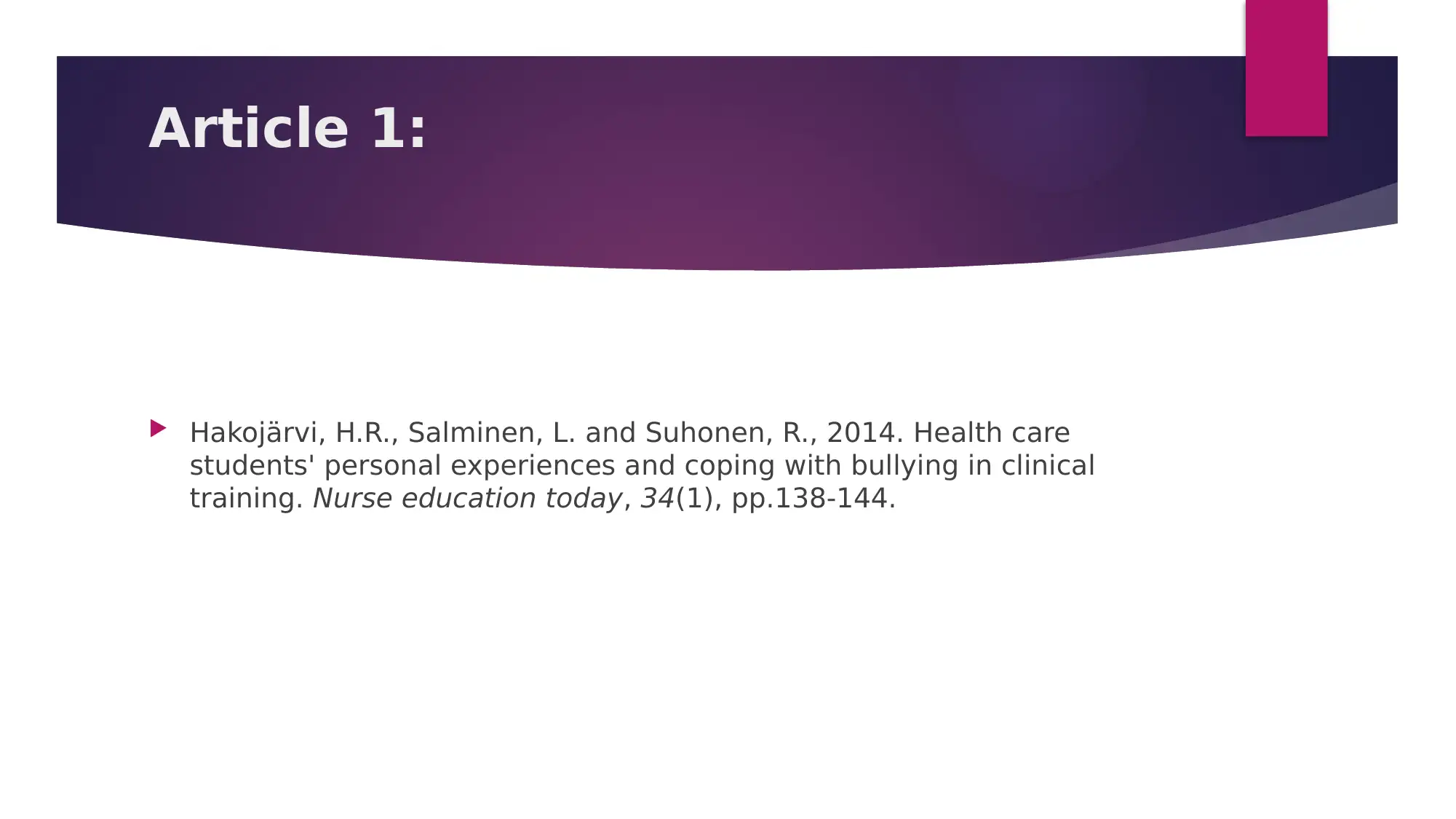
Article 1:
Hakojärvi, H.R., Salminen, L. and Suhonen, R., 2014. Health care
students' personal experiences and coping with bullying in clinical
training. Nurse education today, 34(1), pp.138-144.
Hakojärvi, H.R., Salminen, L. and Suhonen, R., 2014. Health care
students' personal experiences and coping with bullying in clinical
training. Nurse education today, 34(1), pp.138-144.
⊘ This is a preview!⊘
Do you want full access?
Subscribe today to unlock all pages.

Trusted by 1+ million students worldwide
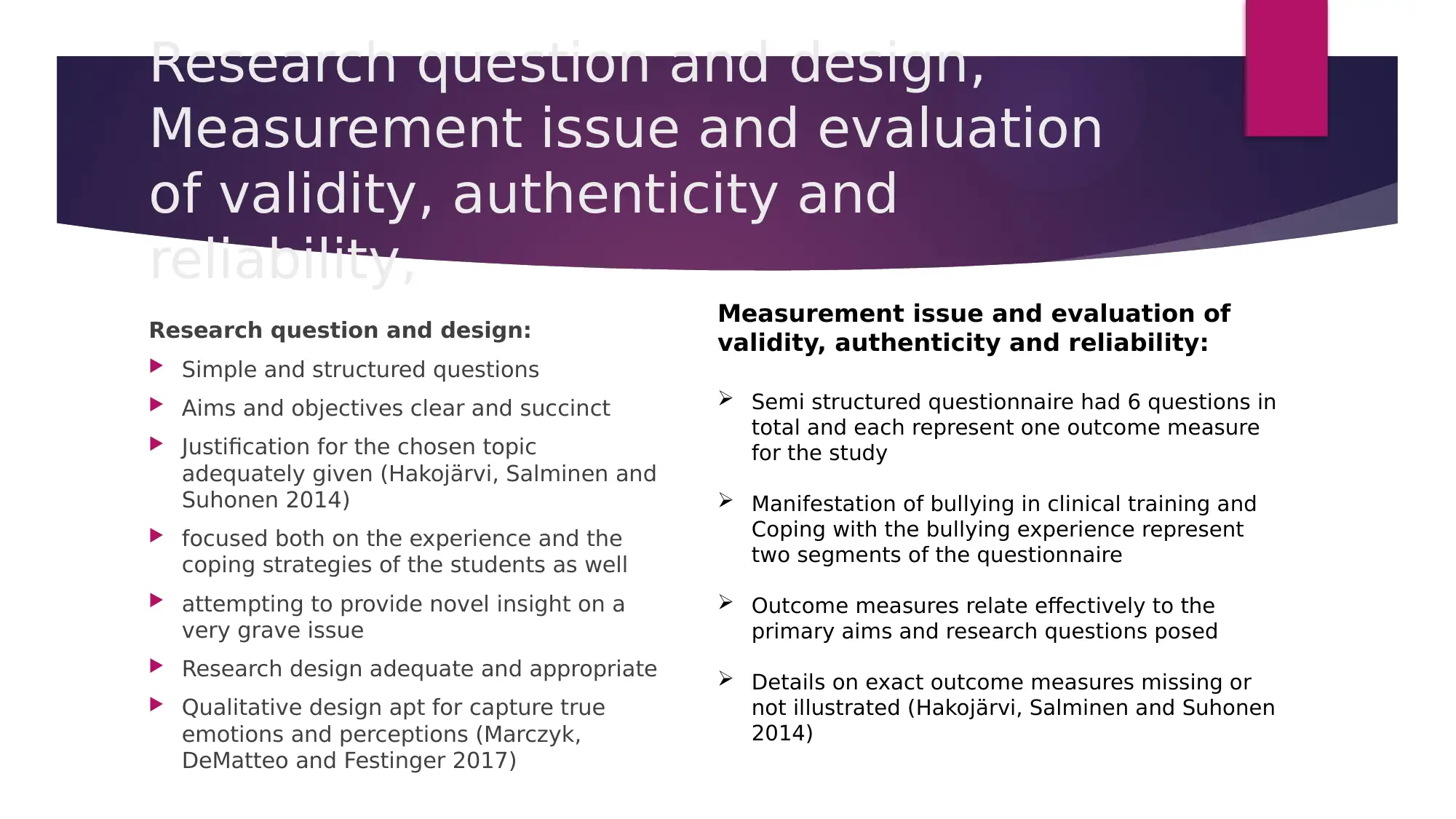
Research question and design,
Measurement issue and evaluation
of validity, authenticity and
reliability,
Research question and design:
Simple and structured questions
Aims and objectives clear and succinct
Justification for the chosen topic
adequately given (Hakojärvi, Salminen and
Suhonen 2014)
focused both on the experience and the
coping strategies of the students as well
attempting to provide novel insight on a
very grave issue
Research design adequate and appropriate
Qualitative design apt for capture true
emotions and perceptions (Marczyk,
DeMatteo and Festinger 2017)
Measurement issue and evaluation of
validity, authenticity and reliability:
Semi structured questionnaire had 6 questions in
total and each represent one outcome measure
for the study
Manifestation of bullying in clinical training and
Coping with the bullying experience represent
two segments of the questionnaire
Outcome measures relate effectively to the
primary aims and research questions posed
Details on exact outcome measures missing or
not illustrated (Hakojärvi, Salminen and Suhonen
2014)
Measurement issue and evaluation
of validity, authenticity and
reliability,
Research question and design:
Simple and structured questions
Aims and objectives clear and succinct
Justification for the chosen topic
adequately given (Hakojärvi, Salminen and
Suhonen 2014)
focused both on the experience and the
coping strategies of the students as well
attempting to provide novel insight on a
very grave issue
Research design adequate and appropriate
Qualitative design apt for capture true
emotions and perceptions (Marczyk,
DeMatteo and Festinger 2017)
Measurement issue and evaluation of
validity, authenticity and reliability:
Semi structured questionnaire had 6 questions in
total and each represent one outcome measure
for the study
Manifestation of bullying in clinical training and
Coping with the bullying experience represent
two segments of the questionnaire
Outcome measures relate effectively to the
primary aims and research questions posed
Details on exact outcome measures missing or
not illustrated (Hakojärvi, Salminen and Suhonen
2014)
Paraphrase This Document
Need a fresh take? Get an instant paraphrase of this document with our AI Paraphraser
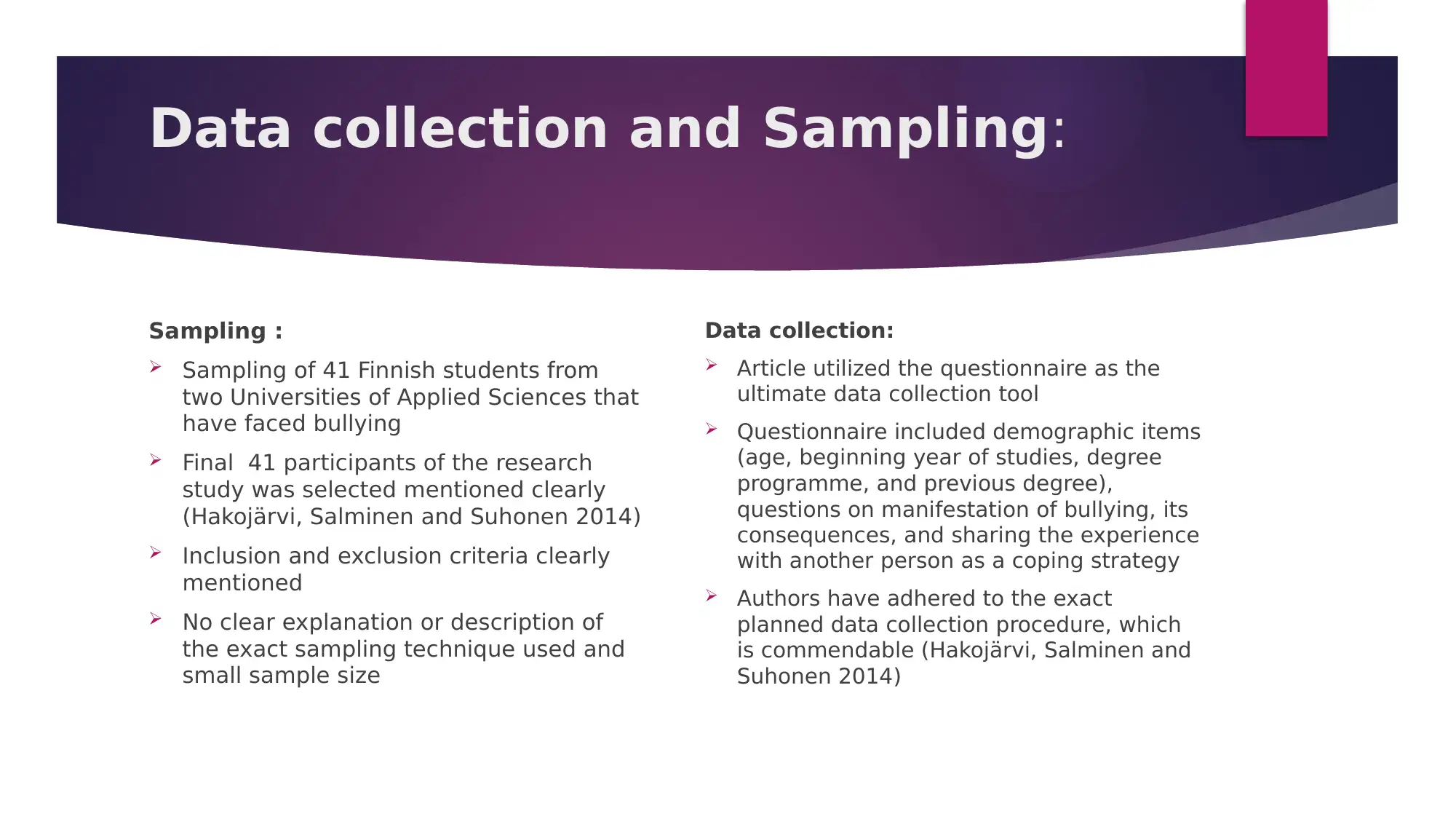
Data collection and Sampling:
Sampling :
Sampling of 41 Finnish students from
two Universities of Applied Sciences that
have faced bullying
Final 41 participants of the research
study was selected mentioned clearly
(Hakojärvi, Salminen and Suhonen 2014)
Inclusion and exclusion criteria clearly
mentioned
No clear explanation or description of
the exact sampling technique used and
small sample size
Data collection:
Article utilized the questionnaire as the
ultimate data collection tool
Questionnaire included demographic items
(age, beginning year of studies, degree
programme, and previous degree),
questions on manifestation of bullying, its
consequences, and sharing the experience
with another person as a coping strategy
Authors have adhered to the exact
planned data collection procedure, which
is commendable (Hakojärvi, Salminen and
Suhonen 2014)
Sampling :
Sampling of 41 Finnish students from
two Universities of Applied Sciences that
have faced bullying
Final 41 participants of the research
study was selected mentioned clearly
(Hakojärvi, Salminen and Suhonen 2014)
Inclusion and exclusion criteria clearly
mentioned
No clear explanation or description of
the exact sampling technique used and
small sample size
Data collection:
Article utilized the questionnaire as the
ultimate data collection tool
Questionnaire included demographic items
(age, beginning year of studies, degree
programme, and previous degree),
questions on manifestation of bullying, its
consequences, and sharing the experience
with another person as a coping strategy
Authors have adhered to the exact
planned data collection procedure, which
is commendable (Hakojärvi, Salminen and
Suhonen 2014)
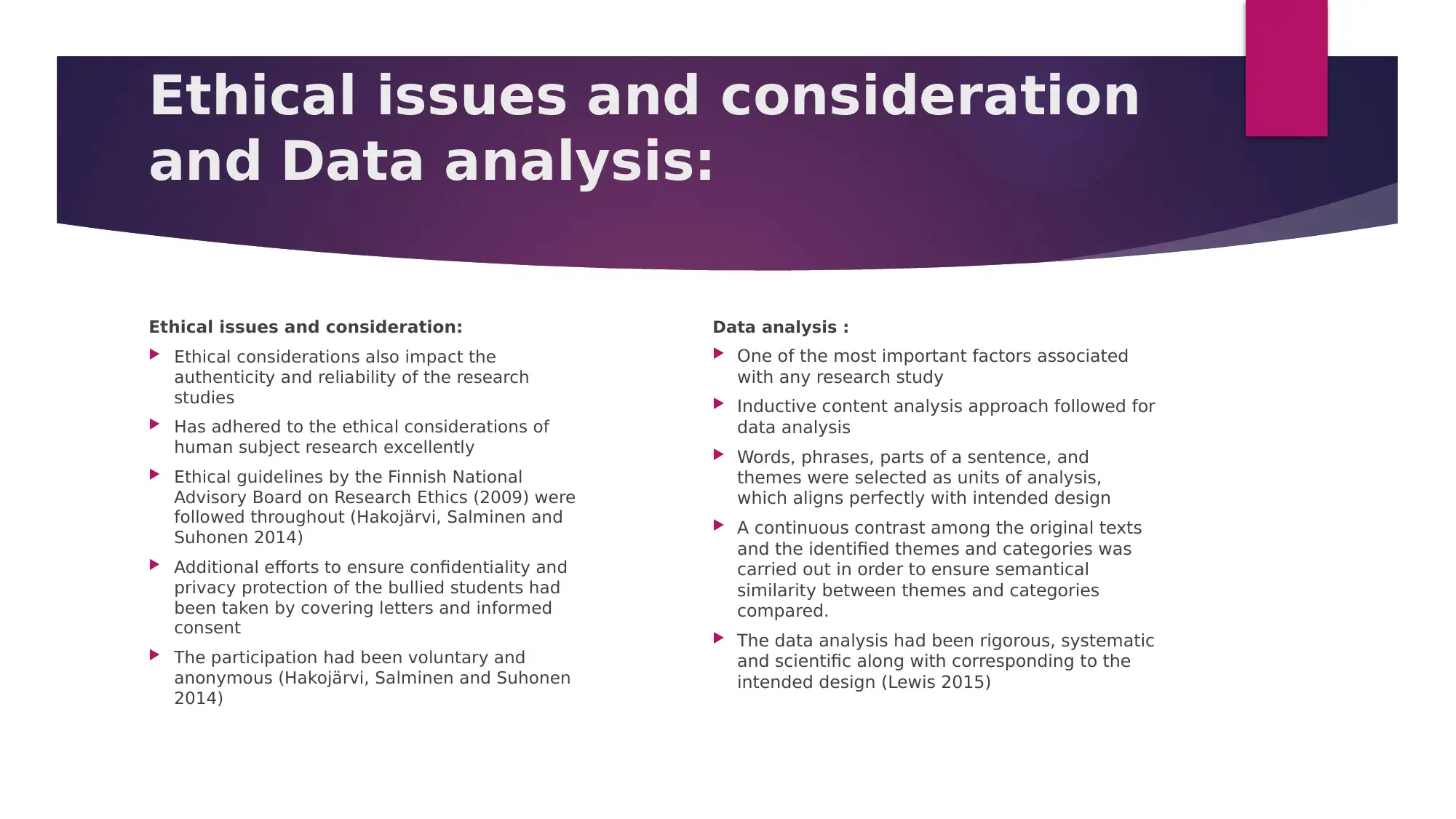
Ethical issues and consideration
and Data analysis:
Ethical issues and consideration:
Ethical considerations also impact the
authenticity and reliability of the research
studies
Has adhered to the ethical considerations of
human subject research excellently
Ethical guidelines by the Finnish National
Advisory Board on Research Ethics (2009) were
followed throughout (Hakojärvi, Salminen and
Suhonen 2014)
Additional efforts to ensure confidentiality and
privacy protection of the bullied students had
been taken by covering letters and informed
consent
The participation had been voluntary and
anonymous (Hakojärvi, Salminen and Suhonen
2014)
Data analysis :
One of the most important factors associated
with any research study
Inductive content analysis approach followed for
data analysis
Words, phrases, parts of a sentence, and
themes were selected as units of analysis,
which aligns perfectly with intended design
A continuous contrast among the original texts
and the identified themes and categories was
carried out in order to ensure semantical
similarity between themes and categories
compared.
The data analysis had been rigorous, systematic
and scientific along with corresponding to the
intended design (Lewis 2015)
and Data analysis:
Ethical issues and consideration:
Ethical considerations also impact the
authenticity and reliability of the research
studies
Has adhered to the ethical considerations of
human subject research excellently
Ethical guidelines by the Finnish National
Advisory Board on Research Ethics (2009) were
followed throughout (Hakojärvi, Salminen and
Suhonen 2014)
Additional efforts to ensure confidentiality and
privacy protection of the bullied students had
been taken by covering letters and informed
consent
The participation had been voluntary and
anonymous (Hakojärvi, Salminen and Suhonen
2014)
Data analysis :
One of the most important factors associated
with any research study
Inductive content analysis approach followed for
data analysis
Words, phrases, parts of a sentence, and
themes were selected as units of analysis,
which aligns perfectly with intended design
A continuous contrast among the original texts
and the identified themes and categories was
carried out in order to ensure semantical
similarity between themes and categories
compared.
The data analysis had been rigorous, systematic
and scientific along with corresponding to the
intended design (Lewis 2015)
⊘ This is a preview!⊘
Do you want full access?
Subscribe today to unlock all pages.

Trusted by 1+ million students worldwide
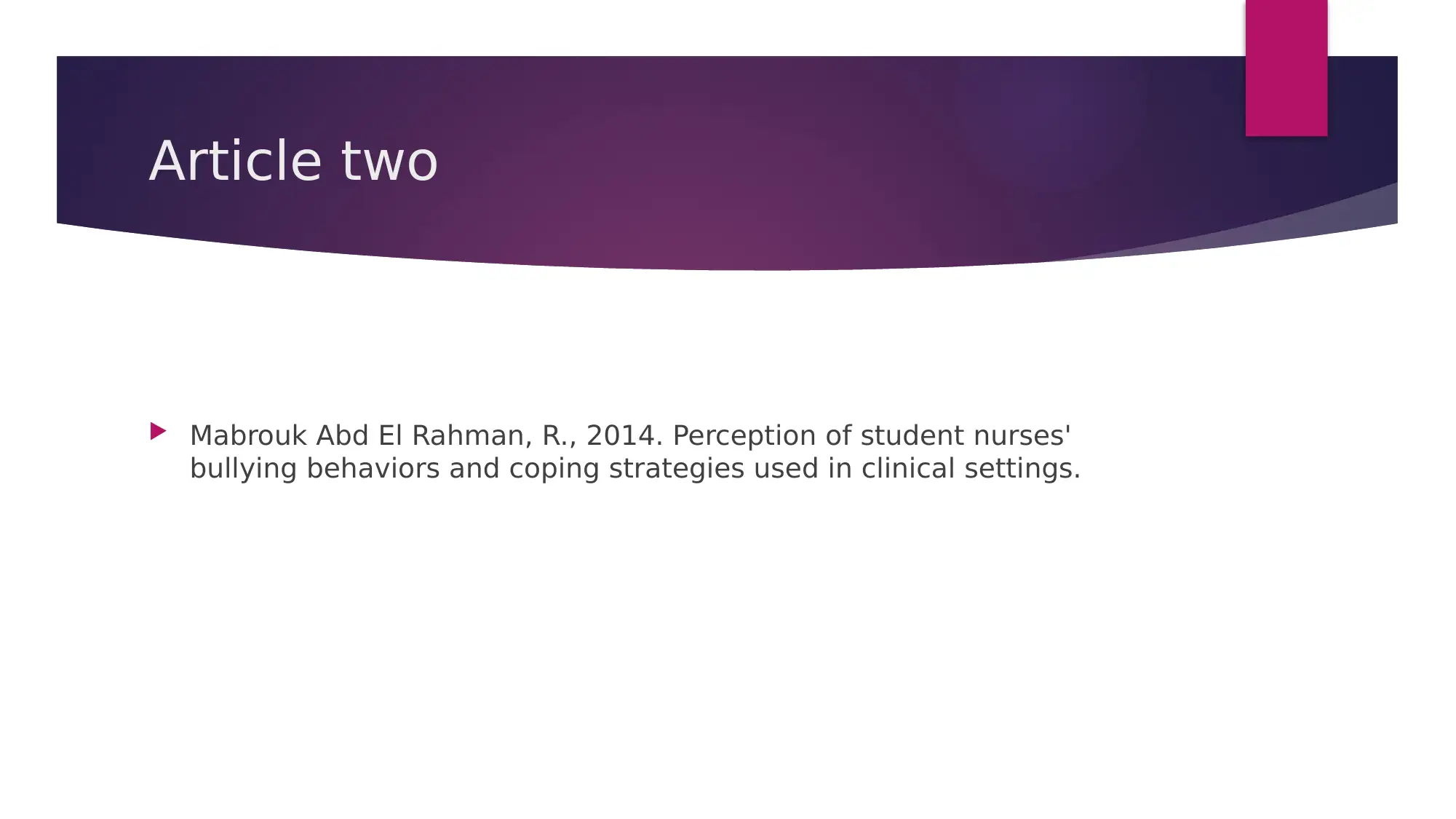
Article two
Mabrouk Abd El Rahman, R., 2014. Perception of student nurses'
bullying behaviors and coping strategies used in clinical settings.
Mabrouk Abd El Rahman, R., 2014. Perception of student nurses'
bullying behaviors and coping strategies used in clinical settings.
Paraphrase This Document
Need a fresh take? Get an instant paraphrase of this document with our AI Paraphraser
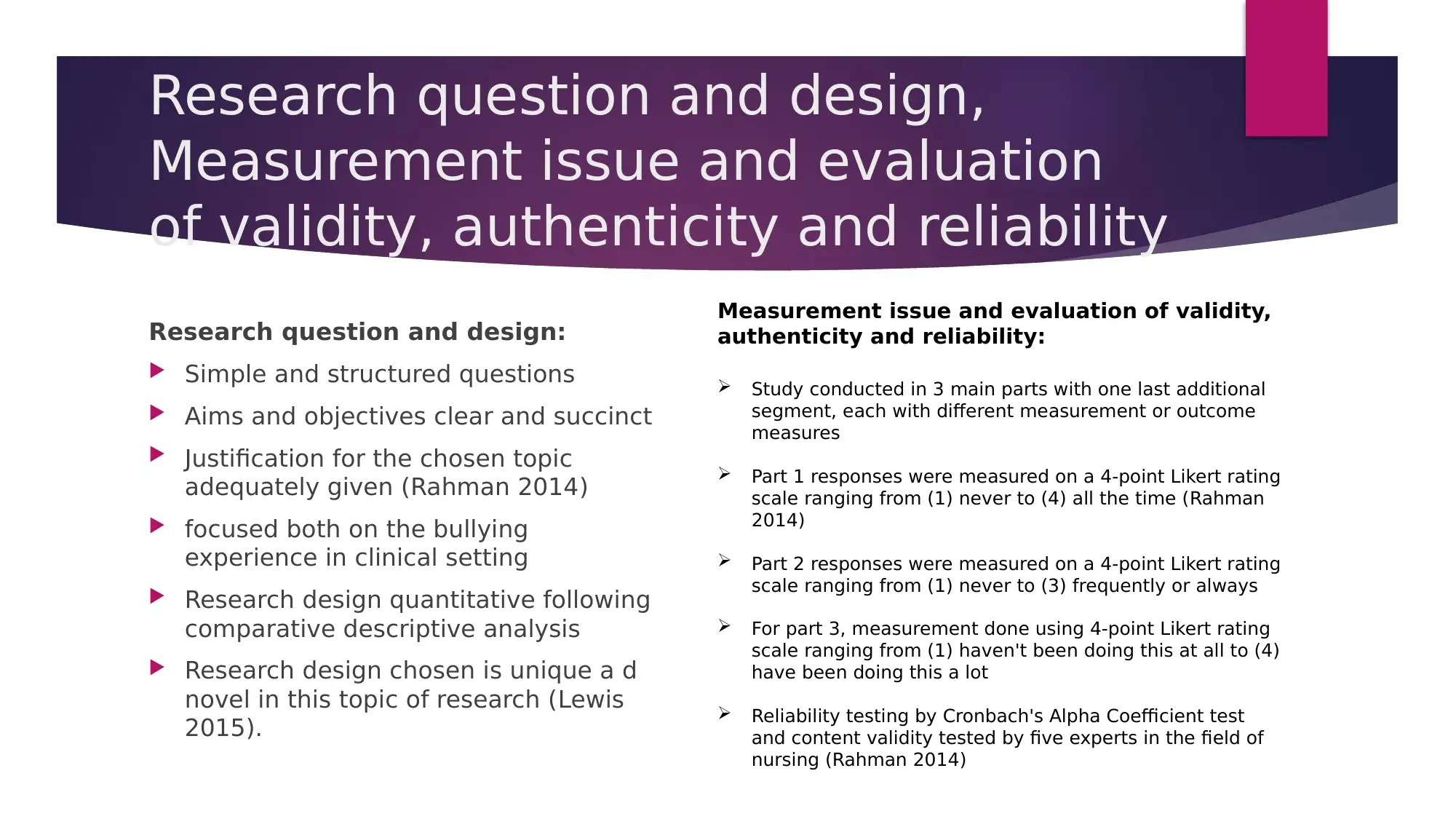
Research question and design,
Measurement issue and evaluation
of validity, authenticity and reliability
Research question and design:
Simple and structured questions
Aims and objectives clear and succinct
Justification for the chosen topic
adequately given (Rahman 2014)
focused both on the bullying
experience in clinical setting
Research design quantitative following
comparative descriptive analysis
Research design chosen is unique a d
novel in this topic of research (Lewis
2015).
Measurement issue and evaluation of validity,
authenticity and reliability:
Study conducted in 3 main parts with one last additional
segment, each with different measurement or outcome
measures
Part 1 responses were measured on a 4-point Likert rating
scale ranging from (1) never to (4) all the time (Rahman
2014)
Part 2 responses were measured on a 4-point Likert rating
scale ranging from (1) never to (3) frequently or always
For part 3, measurement done using 4-point Likert rating
scale ranging from (1) haven't been doing this at all to (4)
have been doing this a lot
Reliability testing by Cronbach's Alpha Coefficient test
and content validity tested by five experts in the field of
nursing (Rahman 2014)
Measurement issue and evaluation
of validity, authenticity and reliability
Research question and design:
Simple and structured questions
Aims and objectives clear and succinct
Justification for the chosen topic
adequately given (Rahman 2014)
focused both on the bullying
experience in clinical setting
Research design quantitative following
comparative descriptive analysis
Research design chosen is unique a d
novel in this topic of research (Lewis
2015).
Measurement issue and evaluation of validity,
authenticity and reliability:
Study conducted in 3 main parts with one last additional
segment, each with different measurement or outcome
measures
Part 1 responses were measured on a 4-point Likert rating
scale ranging from (1) never to (4) all the time (Rahman
2014)
Part 2 responses were measured on a 4-point Likert rating
scale ranging from (1) never to (3) frequently or always
For part 3, measurement done using 4-point Likert rating
scale ranging from (1) haven't been doing this at all to (4)
have been doing this a lot
Reliability testing by Cronbach's Alpha Coefficient test
and content validity tested by five experts in the field of
nursing (Rahman 2014)
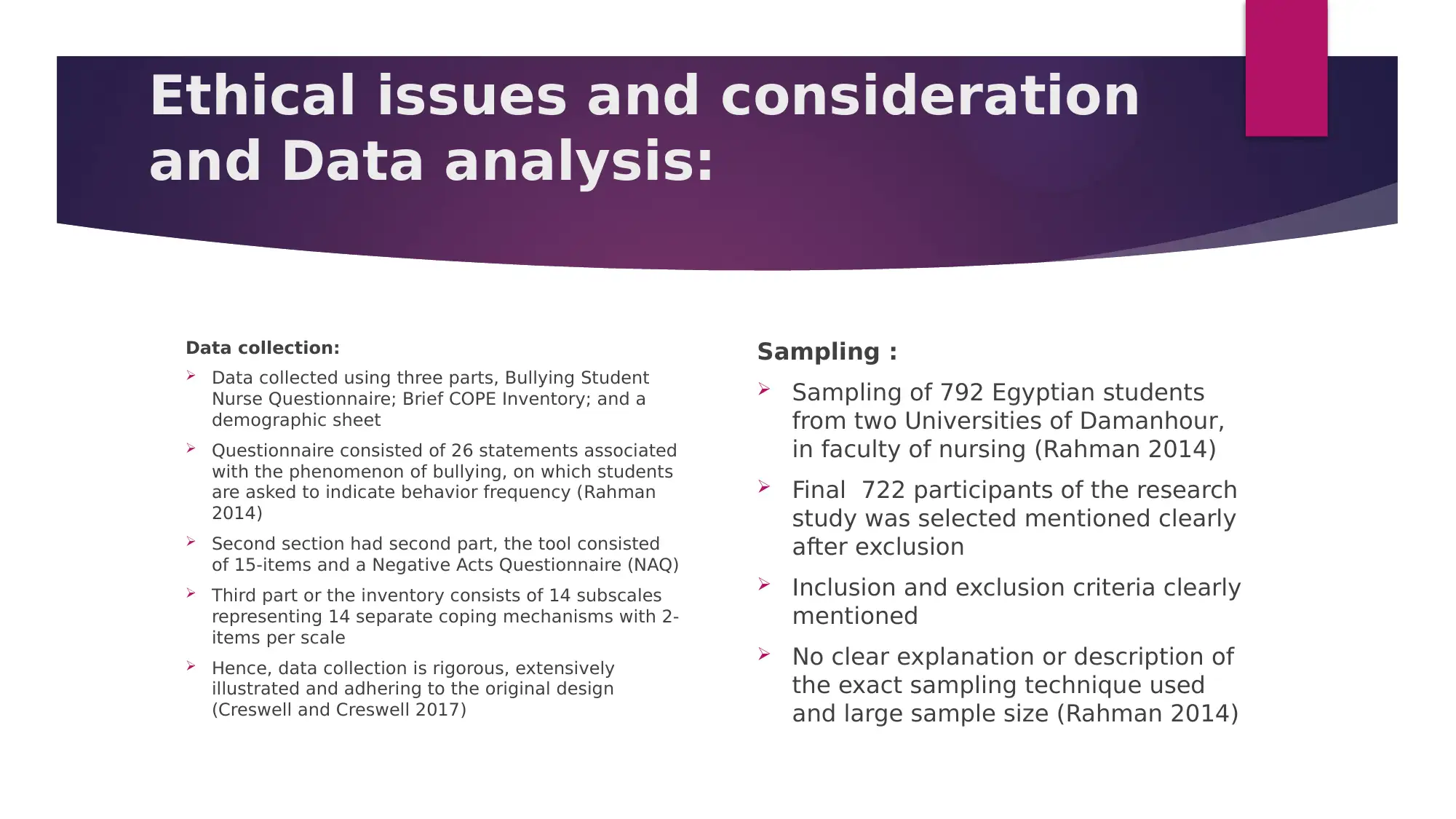
Ethical issues and consideration
and Data analysis:
Data collection:
Data collected using three parts, Bullying Student
Nurse Questionnaire; Brief COPE Inventory; and a
demographic sheet
Questionnaire consisted of 26 statements associated
with the phenomenon of bullying, on which students
are asked to indicate behavior frequency (Rahman
2014)
Second section had second part, the tool consisted
of 15-items and a Negative Acts Questionnaire (NAQ)
Third part or the inventory consists of 14 subscales
representing 14 separate coping mechanisms with 2-
items per scale
Hence, data collection is rigorous, extensively
illustrated and adhering to the original design
(Creswell and Creswell 2017)
Sampling :
Sampling of 792 Egyptian students
from two Universities of Damanhour,
in faculty of nursing (Rahman 2014)
Final 722 participants of the research
study was selected mentioned clearly
after exclusion
Inclusion and exclusion criteria clearly
mentioned
No clear explanation or description of
the exact sampling technique used
and large sample size (Rahman 2014)
and Data analysis:
Data collection:
Data collected using three parts, Bullying Student
Nurse Questionnaire; Brief COPE Inventory; and a
demographic sheet
Questionnaire consisted of 26 statements associated
with the phenomenon of bullying, on which students
are asked to indicate behavior frequency (Rahman
2014)
Second section had second part, the tool consisted
of 15-items and a Negative Acts Questionnaire (NAQ)
Third part or the inventory consists of 14 subscales
representing 14 separate coping mechanisms with 2-
items per scale
Hence, data collection is rigorous, extensively
illustrated and adhering to the original design
(Creswell and Creswell 2017)
Sampling :
Sampling of 792 Egyptian students
from two Universities of Damanhour,
in faculty of nursing (Rahman 2014)
Final 722 participants of the research
study was selected mentioned clearly
after exclusion
Inclusion and exclusion criteria clearly
mentioned
No clear explanation or description of
the exact sampling technique used
and large sample size (Rahman 2014)
⊘ This is a preview!⊘
Do you want full access?
Subscribe today to unlock all pages.

Trusted by 1+ million students worldwide
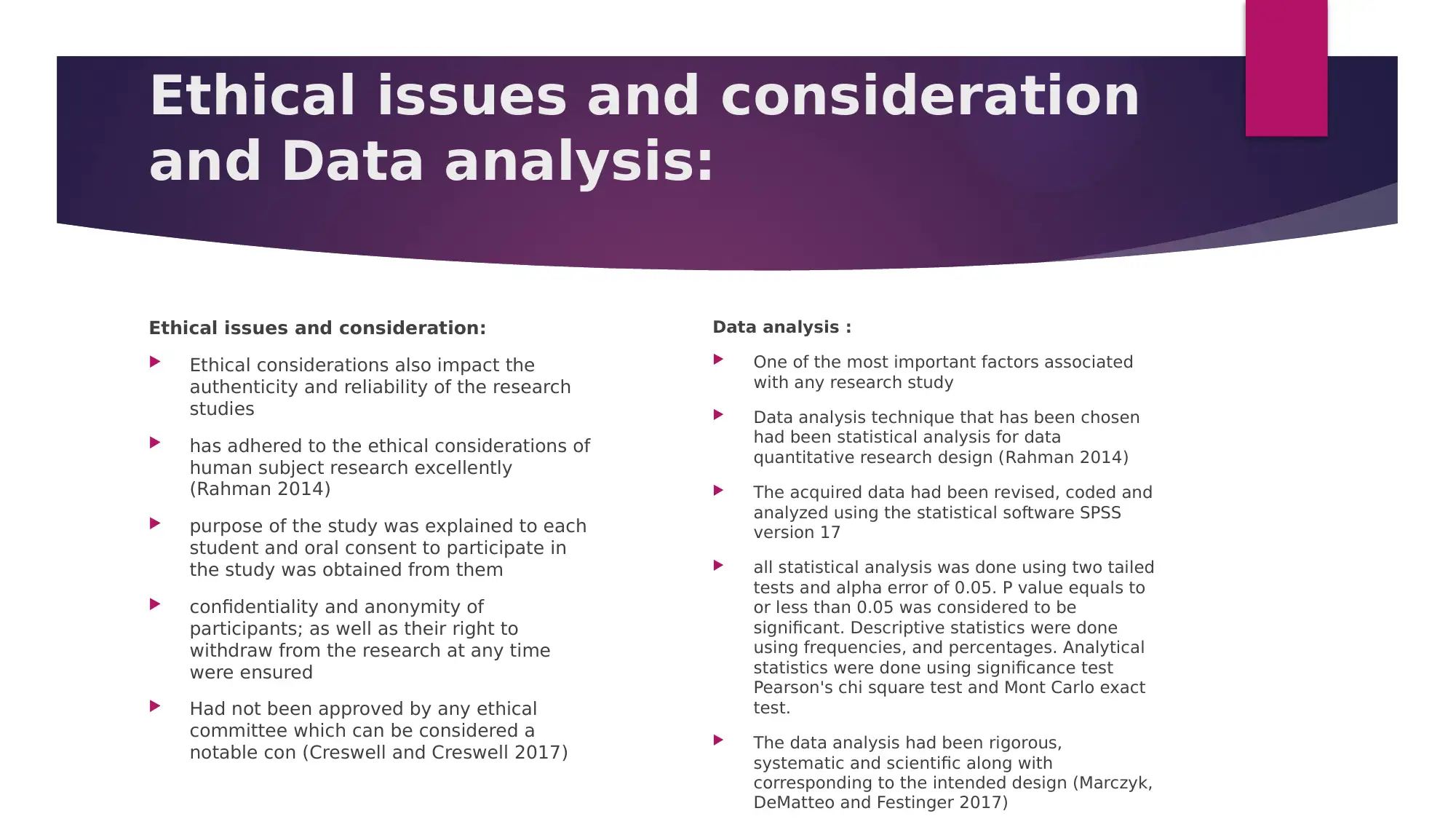
Ethical issues and consideration
and Data analysis:
Ethical issues and consideration:
Ethical considerations also impact the
authenticity and reliability of the research
studies
has adhered to the ethical considerations of
human subject research excellently
(Rahman 2014)
purpose of the study was explained to each
student and oral consent to participate in
the study was obtained from them
confidentiality and anonymity of
participants; as well as their right to
withdraw from the research at any time
were ensured
Had not been approved by any ethical
committee which can be considered a
notable con (Creswell and Creswell 2017)
Data analysis :
One of the most important factors associated
with any research study
Data analysis technique that has been chosen
had been statistical analysis for data
quantitative research design (Rahman 2014)
The acquired data had been revised, coded and
analyzed using the statistical software SPSS
version 17
all statistical analysis was done using two tailed
tests and alpha error of 0.05. P value equals to
or less than 0.05 was considered to be
significant. Descriptive statistics were done
using frequencies, and percentages. Analytical
statistics were done using significance test
Pearson's chi square test and Mont Carlo exact
test.
The data analysis had been rigorous,
systematic and scientific along with
corresponding to the intended design (Marczyk,
DeMatteo and Festinger 2017)
and Data analysis:
Ethical issues and consideration:
Ethical considerations also impact the
authenticity and reliability of the research
studies
has adhered to the ethical considerations of
human subject research excellently
(Rahman 2014)
purpose of the study was explained to each
student and oral consent to participate in
the study was obtained from them
confidentiality and anonymity of
participants; as well as their right to
withdraw from the research at any time
were ensured
Had not been approved by any ethical
committee which can be considered a
notable con (Creswell and Creswell 2017)
Data analysis :
One of the most important factors associated
with any research study
Data analysis technique that has been chosen
had been statistical analysis for data
quantitative research design (Rahman 2014)
The acquired data had been revised, coded and
analyzed using the statistical software SPSS
version 17
all statistical analysis was done using two tailed
tests and alpha error of 0.05. P value equals to
or less than 0.05 was considered to be
significant. Descriptive statistics were done
using frequencies, and percentages. Analytical
statistics were done using significance test
Pearson's chi square test and Mont Carlo exact
test.
The data analysis had been rigorous,
systematic and scientific along with
corresponding to the intended design (Marczyk,
DeMatteo and Festinger 2017)
Paraphrase This Document
Need a fresh take? Get an instant paraphrase of this document with our AI Paraphraser
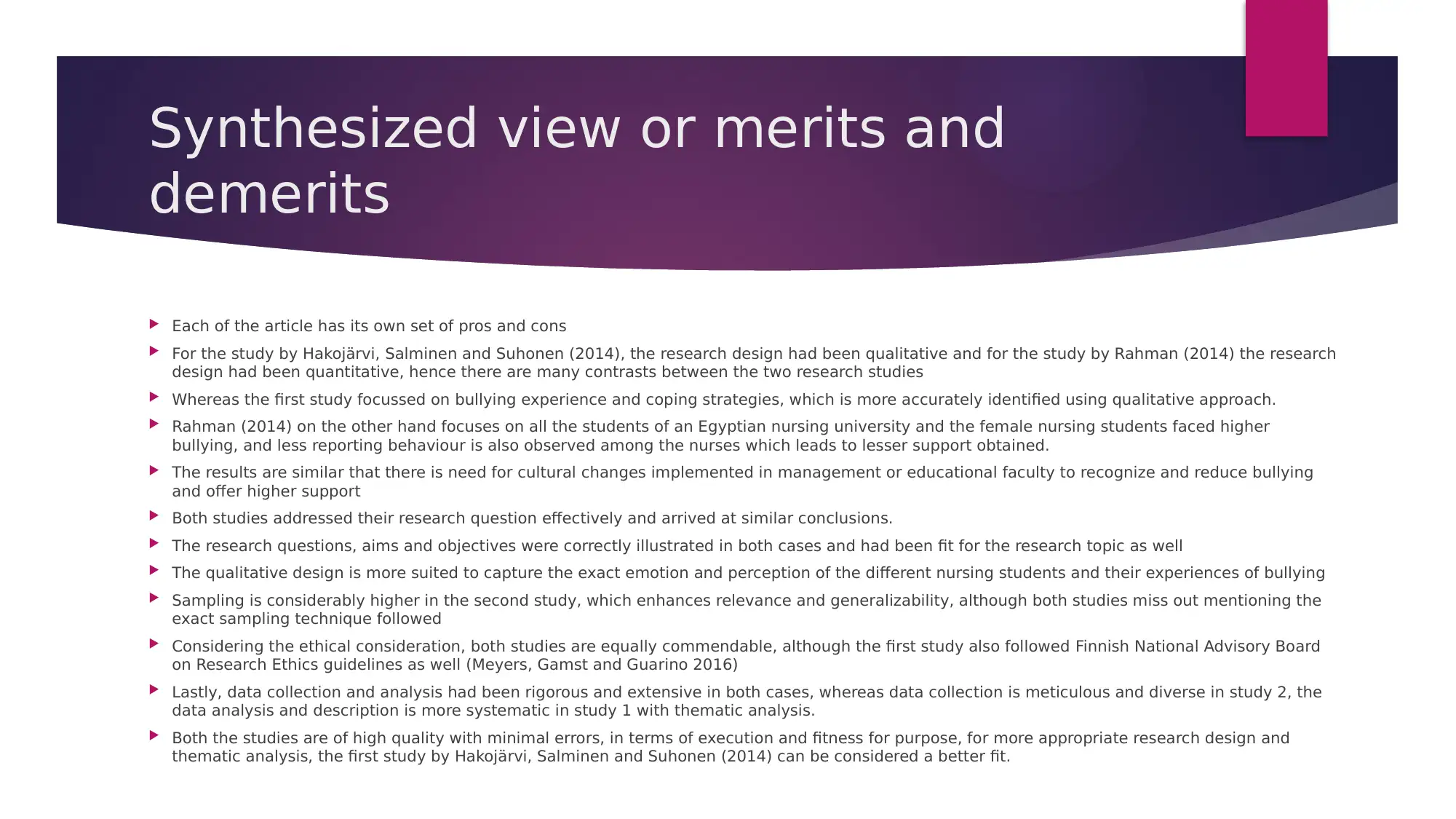
Synthesized view or merits and
demerits
Each of the article has its own set of pros and cons
For the study by Hakojärvi, Salminen and Suhonen (2014), the research design had been qualitative and for the study by Rahman (2014) the research
design had been quantitative, hence there are many contrasts between the two research studies
Whereas the first study focussed on bullying experience and coping strategies, which is more accurately identified using qualitative approach.
Rahman (2014) on the other hand focuses on all the students of an Egyptian nursing university and the female nursing students faced higher
bullying, and less reporting behaviour is also observed among the nurses which leads to lesser support obtained.
The results are similar that there is need for cultural changes implemented in management or educational faculty to recognize and reduce bullying
and offer higher support
Both studies addressed their research question effectively and arrived at similar conclusions.
The research questions, aims and objectives were correctly illustrated in both cases and had been fit for the research topic as well
The qualitative design is more suited to capture the exact emotion and perception of the different nursing students and their experiences of bullying
Sampling is considerably higher in the second study, which enhances relevance and generalizability, although both studies miss out mentioning the
exact sampling technique followed
Considering the ethical consideration, both studies are equally commendable, although the first study also followed Finnish National Advisory Board
on Research Ethics guidelines as well (Meyers, Gamst and Guarino 2016)
Lastly, data collection and analysis had been rigorous and extensive in both cases, whereas data collection is meticulous and diverse in study 2, the
data analysis and description is more systematic in study 1 with thematic analysis.
Both the studies are of high quality with minimal errors, in terms of execution and fitness for purpose, for more appropriate research design and
thematic analysis, the first study by Hakojärvi, Salminen and Suhonen (2014) can be considered a better fit.
demerits
Each of the article has its own set of pros and cons
For the study by Hakojärvi, Salminen and Suhonen (2014), the research design had been qualitative and for the study by Rahman (2014) the research
design had been quantitative, hence there are many contrasts between the two research studies
Whereas the first study focussed on bullying experience and coping strategies, which is more accurately identified using qualitative approach.
Rahman (2014) on the other hand focuses on all the students of an Egyptian nursing university and the female nursing students faced higher
bullying, and less reporting behaviour is also observed among the nurses which leads to lesser support obtained.
The results are similar that there is need for cultural changes implemented in management or educational faculty to recognize and reduce bullying
and offer higher support
Both studies addressed their research question effectively and arrived at similar conclusions.
The research questions, aims and objectives were correctly illustrated in both cases and had been fit for the research topic as well
The qualitative design is more suited to capture the exact emotion and perception of the different nursing students and their experiences of bullying
Sampling is considerably higher in the second study, which enhances relevance and generalizability, although both studies miss out mentioning the
exact sampling technique followed
Considering the ethical consideration, both studies are equally commendable, although the first study also followed Finnish National Advisory Board
on Research Ethics guidelines as well (Meyers, Gamst and Guarino 2016)
Lastly, data collection and analysis had been rigorous and extensive in both cases, whereas data collection is meticulous and diverse in study 2, the
data analysis and description is more systematic in study 1 with thematic analysis.
Both the studies are of high quality with minimal errors, in terms of execution and fitness for purpose, for more appropriate research design and
thematic analysis, the first study by Hakojärvi, Salminen and Suhonen (2014) can be considered a better fit.
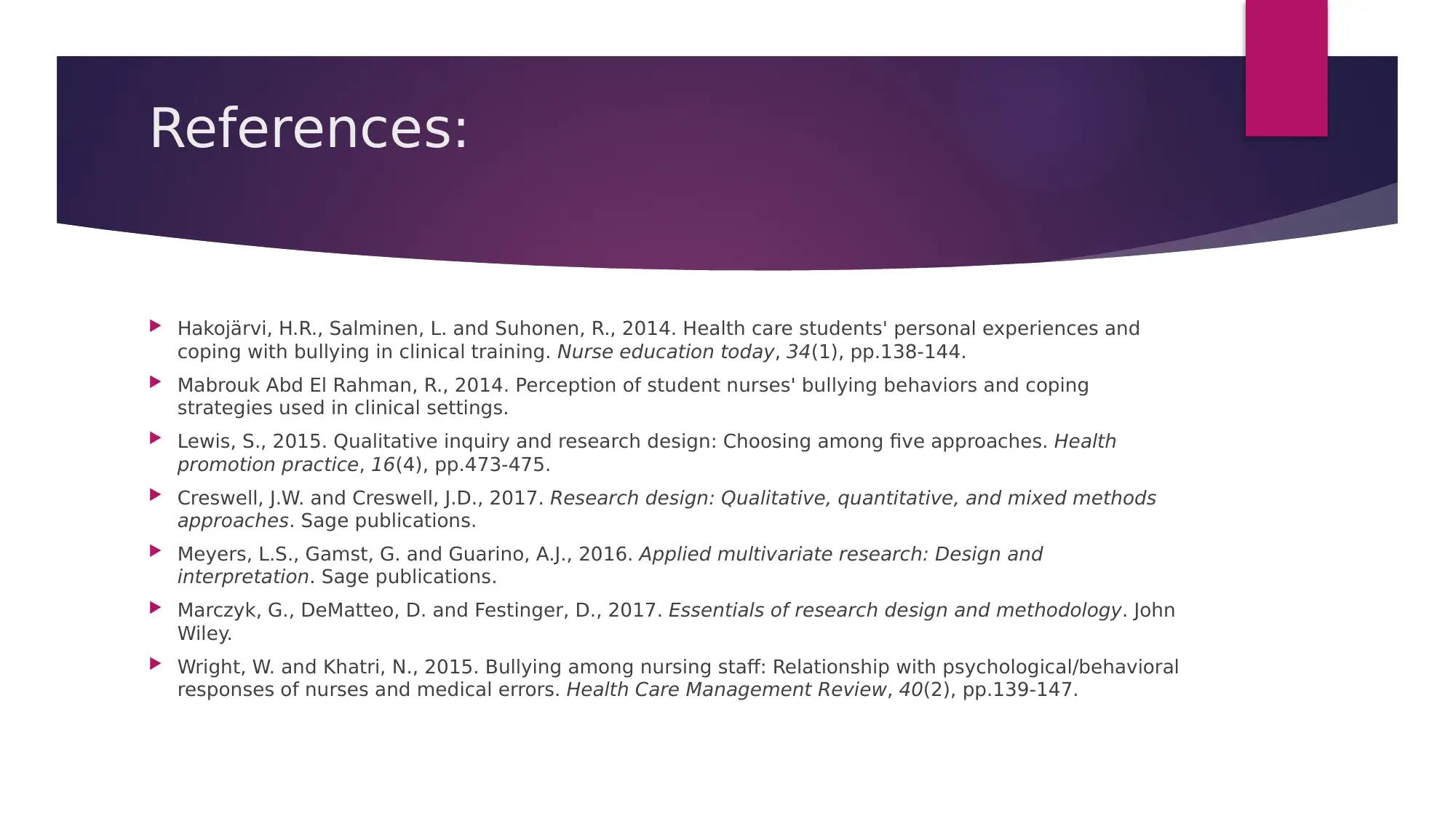
References:
Hakojärvi, H.R., Salminen, L. and Suhonen, R., 2014. Health care students' personal experiences and
coping with bullying in clinical training. Nurse education today, 34(1), pp.138-144.
Mabrouk Abd El Rahman, R., 2014. Perception of student nurses' bullying behaviors and coping
strategies used in clinical settings.
Lewis, S., 2015. Qualitative inquiry and research design: Choosing among five approaches. Health
promotion practice, 16(4), pp.473-475.
Creswell, J.W. and Creswell, J.D., 2017. Research design: Qualitative, quantitative, and mixed methods
approaches. Sage publications.
Meyers, L.S., Gamst, G. and Guarino, A.J., 2016. Applied multivariate research: Design and
interpretation. Sage publications.
Marczyk, G., DeMatteo, D. and Festinger, D., 2017. Essentials of research design and methodology. John
Wiley.
Wright, W. and Khatri, N., 2015. Bullying among nursing staff: Relationship with psychological/behavioral
responses of nurses and medical errors. Health Care Management Review, 40(2), pp.139-147.
Hakojärvi, H.R., Salminen, L. and Suhonen, R., 2014. Health care students' personal experiences and
coping with bullying in clinical training. Nurse education today, 34(1), pp.138-144.
Mabrouk Abd El Rahman, R., 2014. Perception of student nurses' bullying behaviors and coping
strategies used in clinical settings.
Lewis, S., 2015. Qualitative inquiry and research design: Choosing among five approaches. Health
promotion practice, 16(4), pp.473-475.
Creswell, J.W. and Creswell, J.D., 2017. Research design: Qualitative, quantitative, and mixed methods
approaches. Sage publications.
Meyers, L.S., Gamst, G. and Guarino, A.J., 2016. Applied multivariate research: Design and
interpretation. Sage publications.
Marczyk, G., DeMatteo, D. and Festinger, D., 2017. Essentials of research design and methodology. John
Wiley.
Wright, W. and Khatri, N., 2015. Bullying among nursing staff: Relationship with psychological/behavioral
responses of nurses and medical errors. Health Care Management Review, 40(2), pp.139-147.
⊘ This is a preview!⊘
Do you want full access?
Subscribe today to unlock all pages.

Trusted by 1+ million students worldwide
1 out of 13
Related Documents
Your All-in-One AI-Powered Toolkit for Academic Success.
+13062052269
info@desklib.com
Available 24*7 on WhatsApp / Email
![[object Object]](/_next/static/media/star-bottom.7253800d.svg)
Unlock your academic potential
Copyright © 2020–2025 A2Z Services. All Rights Reserved. Developed and managed by ZUCOL.





